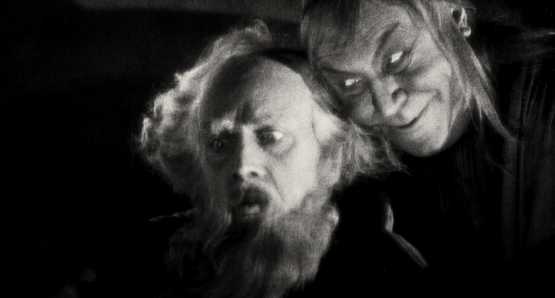
A useful starting point when approaching Friedrich Wilhelm (F. W.) Murnau’s Faust is Rembrandt’s 1652 etching of the same name. In it, we see Faust alone in his library, poring through parchments, surrounded on all sides by scientific paraphernalia. But Rembrandt pays little attention to the things in the room and, instead, directs our focus toward Faust’s desperate face, which stares intently at the otherworldly light shining through his window.
Rembrandt’s etchings are brilliant studies of chiaroscuro, the dramatic interplay of light and darkness in a work of art. An etching is a symbolically-rich form for depicting Faust, the classic, oft-told story of the battle between good and evil for one man’s soul.
Murnau is likewise admired for his mastery of chiaroscuro. The release of Faust in October 1926 and Fritz Lang’s Metropolis three months later marked the beginning of the end of an important era in film history. Between the two world wars, Universum Film Aktiengesellschaft (UFA) was the largest film studio in Germany, but it’s best remembered today for a string of productions in the 1920s. Innovative directors like Murnau, Lang, Robert Wiene, Paul Wegener, and Arthur Robison were encouraged by studio head Erich Pommer to push cinematographic technologies and to experiment freely with set design and lighting.
The result was “German Expressionism,” a style of filmmaking closely associated with other contemporary Modernist art movements, particularly Expressionism and Surrealism. Wiene’s The Cabinet of Dr. Caligari (1920) is often named the first great film of an era that also produced such masterworks as Wegener’s The Golem (1920), Lang’s M (1931), and Murnau’s Nosferatu (1922) and The Last Laugh (1924).
All of the formal trademarks of German Expressionism are on display in the opening scene of Faust. The film begins with what audiences in 1926 would have greeted as a groundbreaking display of special effects—a dramatic, mist-filled battle between Mephisto (played by legendary German actor Emil Jannings), the four horsemen of the apocalypse, and a heavenly angel. Murnau shoots Jannings from a low, cockeyed angle, which distorts the perspective and heightens emotions. (Over the past eighty years, the innovations of German Expressionism have become tired staples of horror movies and music videos.)
When Murnau cuts to our hero, Faust, who is lecturing beside an orrery like the one we see in Rembrandt’s etching, Murnau likewise works in few shades of grey. Instead, Faust is illuminated brightly and made the focal point of the image, while his listeners in the foreground and background are lost in shadow. The exaggerated acting styles and full-blown emotionalism (sentimentality, horror, despair, awe, etc.) of Faust might at first seem mannered to the point of comedy for some twenty-first century viewers. Consider watching it in tandem with Carl Dreyer’s The Passion of Joan of Arc (1928) at #4 on the list or a more recent but equally stylized German film like Wim Wenders’s Wings of Desire (1987) at #12.
It’s worth noting that soon after the release of Faust, Murnau left Germany for Hollywood, where his next project was his masterpiece, Sunrise: A Song of Two Humans (1927), which is #7 on the Top 100. Murnau was recruited personally by William Fox, who was interested in making what we now think of as “prestige” pictures. Once at Fox, Murnau had a tremendous influence on other filmmakers at the lot, most notably the great director of expressionistic melodramas Frank Borzage (check out 7th Heaven [1927] or Street Angel [1928]) and the young John Ford (Ford’s Four Sons [1928] looks like it could have been made at UFA).
—Darren Hughes
- Directed by: F. W. Murnau
- Produced by: Erich Pommer
- Written by: Gerhart Hauptmann Hans Kyser Johann Wolfgang von Goethe
- Music by:
- Cinematography by: Carl Hoffmann
- Editing by: Elfi Böttrich
- Release Date: 1926
- Running Time: 107
- Language: German
Arts & Faith Lists:
2005 Top 100 — #68
2006 Top 100 — #91
2010 Top 100 — #59
2011 Top 100 — #69